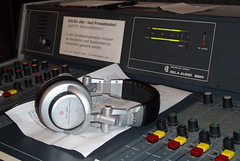Mixing Headphones And Monitors
If you’re mixing on headphones, there are a few things to bear in mind – the differences between a monitor mix and a headphone mix can be quite considerable (and often not for the better), especially if you’re not familiar with the particular effects headphone listening has on your auditory perception…
Phoning It In
Professional producers practically never mix (or master) on headphones. They will always have a set handy for reference checks, but the bulk of the work will be done on monitors.
However, for most of us, issues with space constraints, thin walls or sleeping spouses may all preclude the use of studio monitors, and require the use of headphones for audio production work. While not ideal, it is certainly possible to produce good mixes using only headphones – but you’ll need to know exactly what the cans are doing to your sound.
Music In Your Head
Probably the most dramatic difference is the fact that headphones isolate the stereo channels. On loudspeakers, even though the left and right speakers may be emitting different sounds, you still hear some of the right speaker in your left ear, and vice versa.
This overspill from left to right is called shadowing, and is effectively absent from the headphone listening experience. However, there are a range of plugins available that can recreate this shadowing effect, which may be helpful in simulating the monitor experience when listening on headphones.
For Mac or PC, you can download the freeware plugin VNOPhones over at Vellocet.
For PC, you can try the Crossfeed EQ plugin (also free) from OHL.
For Mac, you have the option of another free plugin, Canz 3D, which can be obtained at Midnight Walrus.
The Headphone Effect
Apart from removing shadowing, headphones also tend to overemphasise or muddy up bass frequencies – a common problem with mixes made on headphones is that they might be particularly weak in the low end.
Of course, different headphone models have varying degrees of bass response, with some actually being too light on the bass. This is the crux of the matter – it’s simply very difficult to accurately move the large volumes of air required to produce a faithful bass signal when you’re using a small cone.
So, being familiar with how your headphones sound, and how they compare to monitors, is an essential part of the process. If you’re looking for a set of new cans, the Sennheiser HD650 and AKG K701 are popular mixing headphones. I have a set of Beyerdynamic DT990’s, which are extremely comfortable, although I do find their bass response a bit soft. However, they are a great reference for picking out small details/problems in the mix that don’t come across clearly on monitors…
